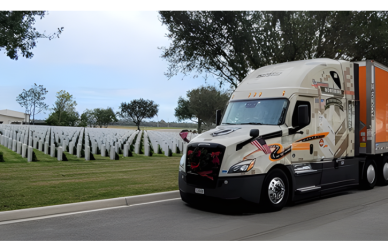While there’s a lot of buzz about battery-electric and hydrogen-powered trucks, it’s important not to overlook the humble tire. After all, until someone invents an anti-gravity device, we’re going to need tires for a long time to come. And even electric trucks will need plenty of them.
Retreading can provide a great solution for fleets looking to cut costs and reduce their carbon footprint. By using fuel-efficient retreads, you can save money on both tires and fuel, making it a win-win situation for your fleet. So don’t overlook the power of retreads just yet – they may be more valuable than you think.
“Many fleets today are looking for ways to maximize their tire investment, and advances in technology and design have made fuel-efficient retreads a smart choice for fleets,” says Johnny McIntosh, senior director, commercial services, Goodyear Commercial.
“Fuel-efficient retreads have lower rolling resistance and require less energy to roll at the same speed as other tires, which translates to less fuel consumption. They can also extend the lifespan of the casing and retread by producing less heat. Increasing the miles to removal also helps increase engine efficiency which can, in turn, lower emissions.”
Fleets that prioritize fuel efficiency know the importance of using retread tires. And now, with advancements in tread design, you can benefit from even more fuel savings without shelling out for a completely new set of tires. When you retread, you can take advantage of the latest tread patterns and compounds, all while remaining environmentally responsible.
“The casing contributes to roughly 60% of the tire’s fuel efficiency, which means optimum fuel efficiency will come from a program that uses fuel-efficient new tires to generate casings for retreading with fuel-efficient retreads, or recaps,” says Michelin North America’s brand manager for retreads, Coy Jones III.
Even if fleets decide not to switch to specialized tire designs, they can still benefit from utilizing fuel-efficient treads on their standard casings, though the advantages may not be as significant.
“You can use fuel-efficient retreads on a non-fuel-efficient casing, but you decrease the overall benefit,” Jones says.
If you’re already part of a retreading program, you’re likely aware of the trade-offs involved. It all depends on your fleet’s priorities. Want long tread life and low tire cost? A standard tread is probably your best bet. If fuel economy is your priority, go for a fuel-efficient tread.
In the past, tires were designed for three main things: traction, wear, and rolling resistance. If you prioritized one of these areas, you had to sacrifice on the others. For example, a long-life tire might have had a higher-wearing tread, but also a reduction in traction.
Luckily, retread manufacturers have improved all three aspects of tire performance, so fleets can focus on their priorities without sacrificing overall. Choose fuel savings, increased traction, or maximum wear – without making major sacrifices.
“There are no trade-offs in terms of performance between the two types of retreads,” says Jason Roanhouse, vice president, North American Bandag Operations, Bridgestone Americas.
“The real difference comes in the design of each tire and retread. Bandag has been innovating tire technology for decades and has developed tread patterns and features that suit the environment for the fleet.”
Although there used to be a notable difference between the lifespan of thin-tread and thick-tread tires, recent advancements in tire technology have led to a significant narrowing of that gap. Improved compounding has even increased the mileage of some thin-tread tires.
While you may get fewer miles out of a tire with half the tread, it could still save you on fuel costs. When deciding whether to opt for thick or thin treads, fleet managers should carefully assess the potential savings associated with each option.
“You may have fewer miles with fuel-efficient retreads, but you save a few more gallons in the tank, which is a higher benefit for fleets and the environment,” notes Jones.
Choosing the right retread tire is similar to buying new tires – it all depends on the specific needs of your fleet. Drive retreads come in open or closed shoulder options, and trailer retreads can have or without a decoupler groove. Additionally, there are caps available for those using wide-base single tires.
To ensure the tire is the best fit for your fleet’s unique requirements, factors such as climate and cargo need to be considered. According to Roanhouse, Bandag dealers are equipped to discuss these elements with potential customers and suggest a tire that aligns with their specific goals and operational needs.
“We understand that not every fleet’s needs are the same, so depending on the type of fleet, there is a Bandag option down to the type of tire available,” he says.
Creating tire programs involves determining the appropriate products and treads that are most effective for the specific driving conditions of a fleet and range of applications. The multitude of choices available can be overwhelming, but building a positive relationship with a service provider can simplify the decision-making process.
“The key to a successful retread program is finding a trusted advisor and dealer who can help you determine the appropriate retread application, and subsequently, creating a customized and efficient tire program for their fleet,” says Goodyear’s McIntosh. “Tire purchase and related maintenance and labor costs are among top expenses for truck and fleet owners, making finding the right retread program essential for cost saving and fuel efficiency.”
Source: Trucking Info











